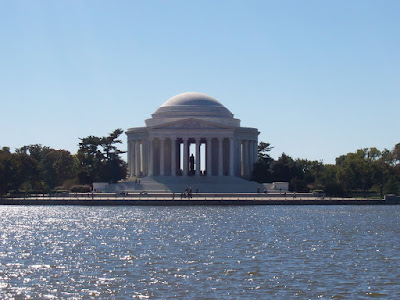The Thomas Jefferson Memorial is a presidential memorial in Washington, D.C. that is dedicated to Thomas Jefferson, an American Founding Father and the third president of the United States. Theneoclassical building was designed by John Russell Pope. It was built by Philadelphia contractor Tyler Nichols. Construction began in 1939, the building was completed in 1943, and the bronze statue of Jefferson was added in 1947. When completed, the memorial occupied one of the last significant sites left in the city.
The Jefferson Memorial is managed by the National Park Service under its National Mall and Memorial Parks division. In 2007, it was ranked fourth on the List of America's Favorite Architecture by theAmerican Institute of Architects.
The current site of the Memorial was originally created using landfill dredged from the Potomac River in the late 1800s. It became a popular bathing beach for Washingtonians and other locals.
It became apparent that the site was well suited for another high-profile memorial since it sat directly south of the White House. By 1901 the Senate Park Commission, better known as the McMillan Commission, had proposed placing a pantheon-like structure on the site hosting "the statues of the illustrious men of the nation, or whether the memory of some individual shall be honored by a monument of the first rank may be left to the future"; no action was ever taken by Congress on this issue.
It became apparent that the site was well suited for another high-profile memorial since it sat directly south of the White House. By 1901 the Senate Park Commission, better known as the McMillan Commission, had proposed placing a pantheon-like structure on the site hosting "the statues of the illustrious men of the nation, or whether the memory of some individual shall be honored by a monument of the first rank may be left to the future"; no action was ever taken by Congress on this issue.
A design competition was held for a memorial to Theodore Roosevelt in 1925. The winning design was submitted by John Russell Pope and consisted of a half-circle memorial situated next to a circular basin. The plan was never funded by Congress and was not built.
The Memorial's chance came in 1934 when President Franklin Roosevelt, an admirer of Jefferson himself, asked the Commission of Fine Arts about the possibility of erecting a memorial to Jefferson, including it in the plans for the Federal Triangle project, which was under construction at the time. Later the same year, Congressman John J. Boylan jumped off FDR's starting point and urged Congress to create the Thomas Jefferson Memorial Commission. Boylan was appointed the Commission's first chairman. Congress eventually appropriated $3 million for a memorial to
The Commission chose John Russell Pope as the architect in 1935. Pope was also the architect of the National Archives Building and original (west) building of the National Gallery of Art. He prepared four different plans for the project, each on a different site. One was on the Anacostia River at the end of East Capitol Street; one at Lincoln Park; one on the south side of the National Mall across from the National Archives; and one situated on the Tidal Basin, directly south of the White House. The Commission preferred the site on the
Construction began on
Construction commenced amid significant opposition. The Commission of Fine Arts never actually approved any design for the Memorial and even published a pamphlet in 1939 opposing both the design and site of the Memorial. In addition, many Washingtonians opposed the site because it was not aligned with L'Enfant'soriginal plan. Finally, many well established elm and cherry trees had to be removed for construction. Construction continued amid the opposition.
In 1939 at, the Memorial Commission hosted a competition to select a sculptor for the planned statue in the center of the Memorial. They received 101 entries and chose six finalists. Of the six, Rudulph Evans was chosen as the main sculptor and Adolph A. Weinman was chosen to sculpt the pediment relief situated above the entrance.
The Jefferson Memorial was officially dedicated by President Roosevelt on
One of the last American public monuments in the, the Memorial was severely criticized even as it was being built, by those who adhered to the modernist argument that dressing 20th century buildings like Greek and Roman temples constituted a "tired architectural lie." More than 60 years ago, Pope responded with silence to critics who dismissed him as part of an enervated architectural elite practicing "styles that are safely dead." As a National Memorial it was administratively listed on the National Register of Historic Places on

No comments:
Post a Comment